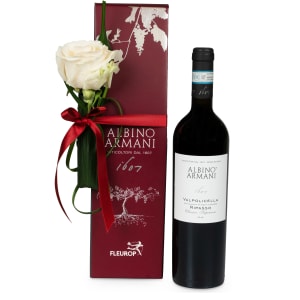Depending on the workpiece, the bottle is either integrated into the flower gift or delivered with a noble gift box.
This full-bodied Amarone della Valpolicella Classico DOCG comes from Albino Armani’s winery in Marano usw.
It is a deep ruby red, very complex in the nose, with a broad range of aromas evocative of ripe red fruits and spices.
It is flavoursome with an excellent structure.
Red wines Amarone and Ripasso by Albino Armani
Here more about our red wines: the Azienda Albino Armani, a wine made from dehydrated grapes, the «accident» called Amarone and a film that will make you dream.
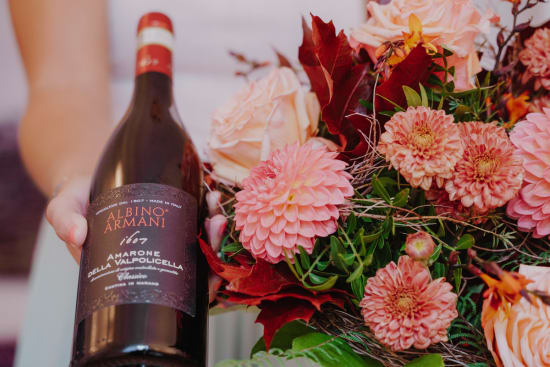
Very special: Amarone della Valpolicella Classico DOCG (75 cl) by Albino Armani
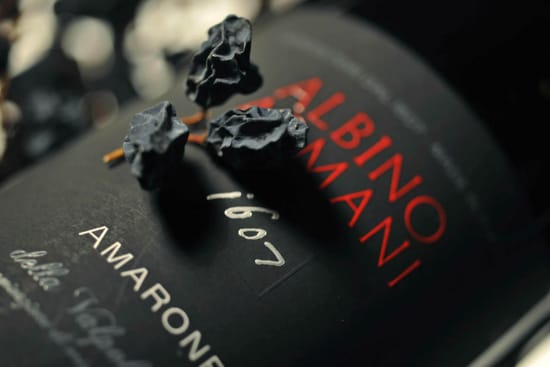
Served at 16-18 °C it is perfect with substantial or even hearty dishes such as braised beef, game, stews and roasts,
but also goes well with raw ham, Bresaola, Coppa or even salami, mature cheese and typical national dishes.
Its luscious aromas and fragrances place it amongst the favourites of many a wine connoisseur.
Its luscious aromas and fragrances place it amongst the favourites of many a wine connoisseur.

The grapes required for this wine are cultivated in the hilly and mountainous Valpolicella region around Marano.
Amarone is special in that it is made from dehydrated grapes (see below to find out more).
It is widely regarded as one of the most intense, highest quality red wines produced anywhere in the world and is featured in the most prestigious wine guides.
It is widely regarded as one of the most intense, highest quality red wines produced anywhere in the world and is featured in the most prestigious wine guides.

Complex: Valpolicella Ripasso Classico Superiore DOC (75 cl) by Albino Armani
Depending on the workpiece, the bottle is either integrated into the flower gift or delivered with a noble gift box.
Ripasso wine is also referred to as the Amarone’s «little brother». Roughly translated, the term «ripasso» means something like «second passing», and that is exactly what happens with the young fermented Valpolicella, which is subsequently added to the fermenting marc recovered from the Amarone production process.
This triggers a second fermentation which gives the Ripasso a fuller, darker, more complex character as the pleasing qualities of a Valpolicella combine with the richness of an Amarone.
Ripasso wine is also referred to as the Amarone’s «little brother». Roughly translated, the term «ripasso» means something like «second passing», and that is exactly what happens with the young fermented Valpolicella, which is subsequently added to the fermenting marc recovered from the Amarone production process.
This triggers a second fermentation which gives the Ripasso a fuller, darker, more complex character as the pleasing qualities of a Valpolicella combine with the richness of an Amarone.
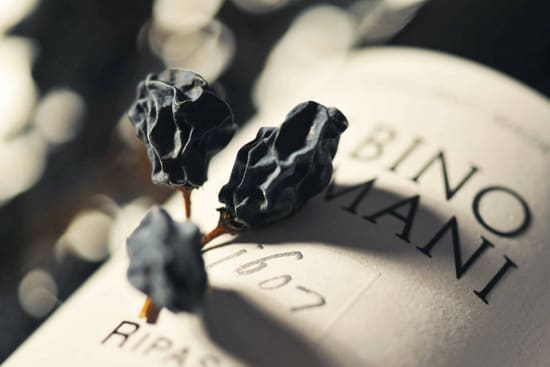
Ripasso has an intense red colour with an elegant fragrance reminiscent of ripe cherries, blackberries and spices.
The taste is pleasing, enduring and warm, with fresh notes.
Served at 16-18 °C it is excellent with tasty appetisers, cooked meat, red meat and mature cheese.
Served at 16-18 °C it is excellent with tasty appetisers, cooked meat, red meat and mature cheese.
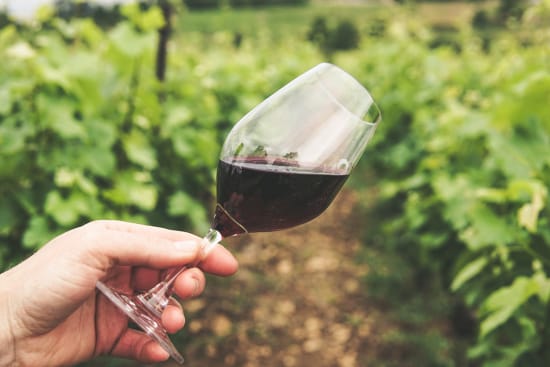
The grapes required for this wine are cultivated in the hilly and mountainous
region of Marano, where the soil is made up of limestone sediments on volcanic rock.

Azienda Albino Armani – over 400 years of wine tradition
No one knows exactly when the Armani family first became involved in winemaking. The first written record dates back to 1607, when Stefano Armani made a notarially certified gift of land with vines and trees to his son Domenico.
The history of the Armani family has been entwined with winemaking for over 400 years ever since then.
The history of the Armani family has been entwined with winemaking for over 400 years ever since then.

The Armani family currently own five wine estates. The oldest estate is located in the
Trentino region where the gently sloping vineyards are well suited to growing Chardonnay, Marzemino and Schiava, etc.
The estate in the Adige valley produces the excellent Foja Tonda, for example, which was threatened with extinction until only a few years ago.
The estate in the Adige valley produces the excellent Foja Tonda, for example, which was threatened with extinction until only a few years ago.

Organic wines are produced in the San Polo di Piave winery in the Province of Treviso. The fourth estate is located in the heart of the Doc Friuli Grave region, where our Prosecco is made.
Finally, the fifth estate is the one where our two red wines, Amarone and Ripasso, are produced.
Finally, the fifth estate is the one where our two red wines, Amarone and Ripasso, are produced.
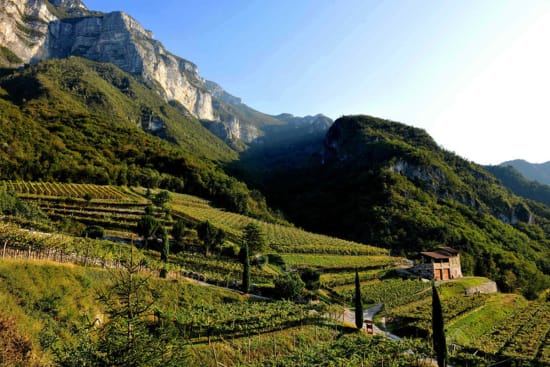
In the hilly and mountainous Valpolicella region around Marano, the Armani family’s vineyards take up the very last inch of elevated cultivable land.
This ecological context provides ideal conditions for a range of indigenous grape varieties, all of which are perfectly exposed to the sun and produce wines of unmistakeable quality.
This ecological context provides ideal conditions for a range of indigenous grape varieties, all of which are perfectly exposed to the sun and produce wines of unmistakeable quality.
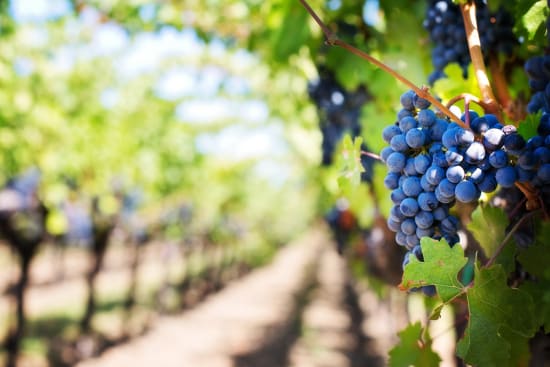
Amarone - made from dehydrated grapes
Amarone is known for its distinct aroma and wonderful fragrances, qualities deriving
from the dehydrated grapes from which it is produced (see below for explanation).
To set the process in motion, the best grapes are stored for three to five months after harvesting on special grids on huge shelves where they are left to dry out slowly, in a well aired environment.
This phase is known as «appassimento» (meaning withering/shrinkage).
To set the process in motion, the best grapes are stored for three to five months after harvesting on special grids on huge shelves where they are left to dry out slowly, in a well aired environment.
This phase is known as «appassimento» (meaning withering/shrinkage).

The grapes are turned over, checked and sorted at regular intervals. The water in the grapes tends to evaporate,
leaving behind a concentrated blend of acid, sugar and extract substances.
After drying the grapes are pressed and fermented, which can take anything up to 60 days.
The production process continues even after that. Nevertheless, the young wine is transferred to barrels where it matures for at least three years until it goes on the market. The sweet-tasting marc left over from the Amarone production process is used to make Ripasso wine.
The production process continues even after that. Nevertheless, the young wine is transferred to barrels where it matures for at least three years until it goes on the market. The sweet-tasting marc left over from the Amarone production process is used to make Ripasso wine.

The «raisin technique» used by the Greeks and Romans
Making wine from dried grapes is a technique that dates back to antiquity. The ancient Greeks and Romans adopted the habit of
twisting bunches of grapes
while still hanging on the vine in order to interrupt the flow of juices, and the grapes slowly turned into raisins.
This increased the concentration of sugar in the fruit and produced delicious wines with a high alcohol content. These wines also lasted longer, so could be sold to customers further away.
This increased the concentration of sugar in the fruit and produced delicious wines with a high alcohol content. These wines also lasted longer, so could be sold to customers further away.
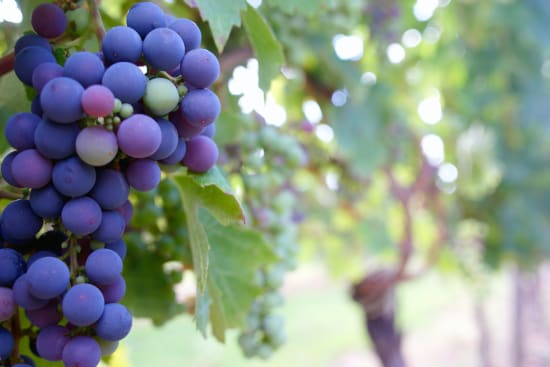
It is a technique that is still used even today, particularly in warm, dry southern climes –
it works less well in northern Italy, where conditions are generally more humid.
An alternative method was therefore developed whereby the grapes are dried in well aired barns and storage rooms or placed on reed mats or frames.
An alternative method was therefore developed whereby the grapes are dried in well aired barns and storage rooms or placed on reed mats or frames.

In this well aired environment,
the grapes are turned over, rearranged and sorted to eliminate any which fail to meet the established quality criteria. The remainder dry slowly, producing sweet, aromatic raisins.
The longer and more carefully the fruits are dried, the more concentrated the ingredients.
The best Amarone della Valpolicella by Albino Armani is produced from grapes which are allowed to dry almost to raisins before they are fermented.
The best Amarone della Valpolicella by Albino Armani is produced from grapes which are allowed to dry almost to raisins before they are fermented.
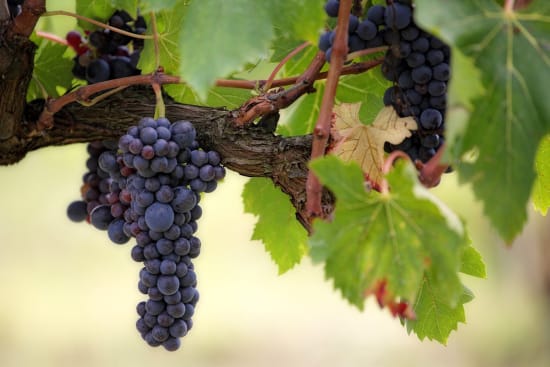
Amarone came about by accident
We have a forgetful 16th century cellar master to thank for Amarone. Back then, dried grapes were used to make a sweet
red wine known as «Recioto della Valpolicella», a wine that is still enjoyed even today.
The grapes used to make this particular wine are dried even further, producing a much higher sugar content. The fermentation process is also halted prematurely, so that part of the sugar remains in the wine unfermented, imparting the typically sweet flavour.
The grapes used to make this particular wine are dried even further, producing a much higher sugar content. The fermentation process is also halted prematurely, so that part of the sugar remains in the wine unfermented, imparting the typically sweet flavour.
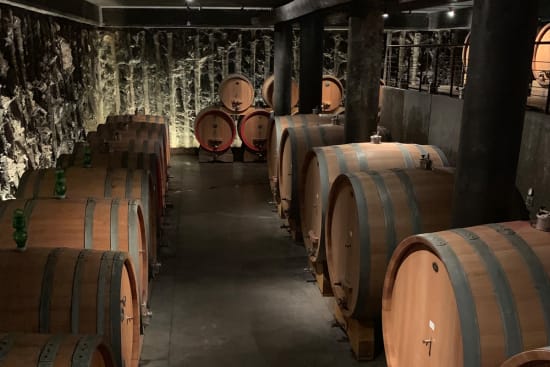
Once, the cellar master obviously forgot to stop the fermentation process underway in one of the barrels,
leaving the red wine enough time to ferment completely so that all the sugar was converted to alcohol.
The barrel was eventually found, and the wine tasted – and Amarone was born!
Dry rather than sweet, Amarone was much appreciated. It has been known as the brother of Recioto della Valpolicella ever since.
Dry rather than sweet, Amarone was much appreciated. It has been known as the brother of Recioto della Valpolicella ever since.
Into the Wine – the power of images (short video)
Like to take a short tour of Albino Armani's world? Then don't miss this video with a jazzy soundtrack.
The images are powerful and dreamy: with breathtaking scenery, people hard at work, expressive faces, an osteria in Trentino, picturesque stone houses, cellars, horses and a dog who appears to live in a wine barrel like Diogenes.
The images are powerful and dreamy: with breathtaking scenery, people hard at work, expressive faces, an osteria in Trentino, picturesque stone houses, cellars, horses and a dog who appears to live in a wine barrel like Diogenes.
More loving & high-quality additional gifts
Gottlieber specialties
Here you will find the story of a woman who developed normal wafers into a speciality and find out what makes our cocoa almonds so special.
Chocolate from Maestrani
Why is chocolate good for morning grouchs? Who paid with cocoa beans? And why do ladybirds bring good luck? Answers to these and other questions can be found here.
Honey from Bee-Family
Want to learn more about an irresistible honey? To dive into the world of honey, honey hunters and bee transhumance and know how to store honey? Read here.
Tea from Gottlieber
Which tea is called «gunpowder»? Which type of tea was picked by monkeys? And how is Moroccan tea made? Answers to these questions and more can be found here.
Red wines Amarone and Ripasso by Albino Armani
Here more about our red wines: the Azienda Albino Armani, a wine made from dehydrated grapes, the «accident» called Amarone and a film that will make you dream.
Prosecco Albino Armani
When may a wine be labelled Prosecco? What is meant by Brut or Extra Dry? Who is Albino Armani? And what can dreams look like? Here you will find the answers.
Prosecco Albino Armani Rosé DOC
What does it taste like? What goes well with it? What does Millesimato or SQNPI mean? And how sustainable is Armani? You can find the answers to these and other questions here.
Teddy bears
More about the «birth» and success story of the cute teddies as well as all kinds of information about teddy bear days, teddy bear records or teddy museums can be found here.



